
C2
.pdf
A R T A N D S O C I E T Y
Enheduanna, Priestess and Poet
In the man’s world of ancient Akkad, one woman stands out prom- inently—Enheduanna, daughter of King Sargon and priestess of the moon god Nanna at Ur. Her name appears in several inscriptions, and she was the author of a series of hymns in honor of the goddess Inanna. Enheduanna’s is the oldest recorded name of a poet, male or female. Indeed, hers is the earliest known name of the author of any
literary work in world history.
The most important surviving object associated with Enheduanna is the alabaster disk (FIG. 2-14) found at Ur in several fragments in the residence of the priestess of Nanna. The reverse bears a cuneiform inscription identifying Enheduanna as the “wife of Nanna” and “daughter of Sargon, king of the world” and credits Enheduanna with erecting an altar to Nanna in his temple. The dedication of the relief to the moon god explains its unusual round format, which corresponds to the shape of the full moon. The front of the disk shows four figures approaching a four-story ziggurat. The first figure is a nude man who is either a priest or Enheduanna’s assistant. He pours a libation into a plant stand. The second figure, taller than the rest and wearing the headgear of a priestess, is Enheduanna herself. She raises her right hand in a gesture of greeting and respect for the god. Two figures, probably female attendants, follow her.
Artworks created to honor women are rare in Mesopotamia and in the ancient world in general, and Enheduanna’s is the oldest known. Enheduanna was, however, a princess and priestess, not a ruler in her own right, and her disk pales in comparison to the monuments erected almost a thousand years later in honor of Queen Hatshepsut of Egypt (see “Hatshepsut,” Chapter 3, page 54).
1 in.
2-14 Votive disk of Enheduanna, from Ur (modern Tell Muqayyar), Iraq, ca. 2300–2275 BCE. Alabaster, diameter 10 . University of Pennsylvania Museum of Archaeology and Anthropology, Philadelphia.
Enheduanna, daughter of Sargon of Akkad and priestess of Nanna at Ur, is the first author whose name is known. She is the tallest figure on this disk that she dedicated in honor of the moon god.
the mountainside. The Akkadian artist adhered to older conventions in many details, especially by portraying the king and his soldiers in composite views and by placing a frontal two-horned helmet on Naram-Sin’s profile head. But the sculptor showed daring innovation in creating a landscape setting for the story and placing the figures on successive tiers within that landscape. For the first time, an artist rejected the standard way of telling a story in a series of horizontal registers, the compositional formula that had been the rule for a millennium. The traditional frieze format was used, however, for an alabaster disk (FIG. 2-14) that is in other respects one of the
most remarkable discoveries ever made in the ancient Near East (see “Enheduanna, Priestess and Poet,” above).
ZIGGURAT, UR Around 2150 BCE, a mountain people, the Gutians, brought Akkadian power to an end. The cities of Sumer, however, soon united in response to the alien presence, drove the Gutians out of Mesopotamia, and established a Neo-Sumerian state ruled by the kings of Ur. This age, which historians call the Third Dynasty of Ur, saw the construction of the ziggurat (FIG. 2-15) at Ur, one of the largest in Mesopotamia. Built about a millennium later than that at
2-15 Ziggurat (northeastern facade with restored stairs), Ur (modern Tell Muqayyar), Iraq, ca. 2100 BCE.
The Ur ziggurat is one of the largest in Mesopotamia. It has three ramplike stairways of a hundred steps each that originally ended at a gateway to a brick temple, which does not survive.
Akkad and the Third Dynasty of Ur |
27 |
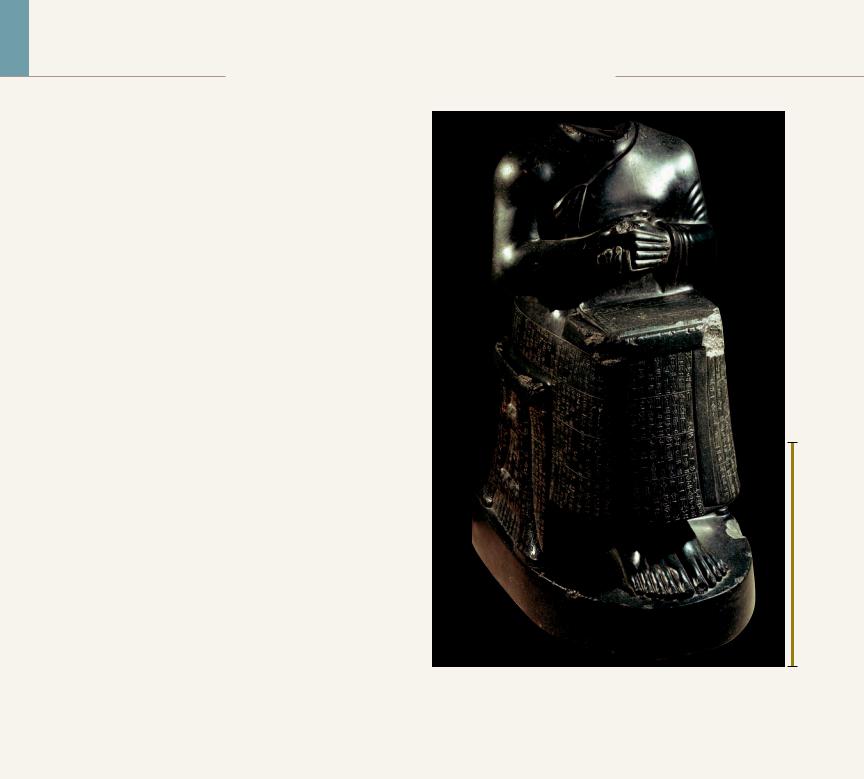
W R I T T E N S O U R C E S
The Piety of Gudea
One of the central figures of the Neo-Sumerian age was Gudea of Lagash. Nearly two dozen portraits of him survive. All stood in temples where they could render perpetual service to the gods and
intercede with the divine powers on his behalf. Although a powerful ruler, Gudea rejected the regal trappings of Sargon of Akkad and his successors in favor of a return to the Sumerian votive tradition of the Eshnunna statuettes (FIG. 2-6). Like the earlier examples, many of Gudea’s statues are inscribed with messages to the gods of Sumer. One from Girsu says, “I am the shepherd loved by my king [Ningirsu, the god of Girsu]; may my life be prolonged.” Another, also from Girsu, as if in answer to the first, says,“Gudea, the builder of the temple, has been given life.” Some of the inscriptions help explain why Gudea was portrayed the way he was. For example, his large chest is a sign that the gods have given him fullness of life and his muscular arms reveal his god-given strength. Other inscriptions underscore that his large eyes signify that his gaze is perpetually fixed on the gods (compare FIG. 2-6).
Gudea built or rebuilt, at great cost, all the temples in which he placed his statues. One characteristic portrait (FIG. 2-16) depicts the pious ruler of Lagash seated with his hands clasped in front of him in a gesture of prayer. The head is unfortunately lost, but the statue is of unique interest because Gudea has a temple plan drawn on a tablet on his lap. It is the plan for a new temple dedicated to Ningirsu. Gudea buried accounts of his building enterprises in the temple foundations. The surviving texts describe how the Neo-Sumerians prepared and purified the sites, obtained the materials, and dedicated the completed temples. They also record Gudea’s dreams of the gods asking him to erect temples in their honor, promising him prosperity if he fulfilled his duty. In one of these dreams, Ningirsu addresses Gudea:
When, O faithful shepherd Gudea, thou shalt have started work for me on Erinnu, my royal abode [Ningirsu’s new temple], I will call up in heaven a humid wind. It shall bring the abundance from
on high. . . . All the great fields will bear for thee; dykes and canals will swell for thee; . . . good weight of wool will be given in thy time.*
*Translated by Thorkild Jacobsen, in Henri Frankfort, The Art and Architecture of the Ancient Orient, 5th ed. (New Haven: Yale University Press, 1996), 98.
1 ft.
2-16 Seated statue of Gudea holding temple plan, from Girsu Diorite, 2 5 high. Louvre, Paris.
Gudea of Lagash built or rebuilt many temples and placed statues of himself in all of them. In this seated portrait, Gudea has on his lap a plan of the new temple he erected to Ningirsu.
Uruk (FIGS. 2-2 and 2-3), the Ur ziggurat is much grander. The base is a solid mass of mud brick 50 feet high. The builders used baked bricks laid in bitumen, an asphaltlike substance, for the facing of the entire monument. Three ramplike stairways of a hundred steps each converge on a tower-flanked gateway. From there another flight of steps probably led to the temple proper, which does not survive.
GUDEA OF LAGASH The most conspicuous preserved sculptural monuments of the Neo-Sumerian age portray Gudea, the ensi of Lagash around 2100 BCE (see “The Piety of Gudea,” above). His statues (FIG. 2-16) show him seated or standing, hands tightly
clasped, head shaven, sometimes wearing a woolen brimmed hat, and always dressed in a long garment that leaves one shoulder and arm exposed. Gudea was zealous in granting the gods their due, and the numerous statues he commissioned are an enduring testimony to his piety—and to his wealth and pride. All his portraits are of polished diorite, a rare and costly dark stone that had to be imported. Diorite is also extremely hard and difficult to carve. The prestige of the material—which in turn lent prestige to Gudea’s portraits—is evident from an inscription on one of Gudea’s statues: “This statue has not been made from silver nor from lapis lazuli, nor from copper nor from lead, nor yet from bronze; it is made of diorite.”
28 Chapter 2 T H E A N C I E N T N E A R E A S T
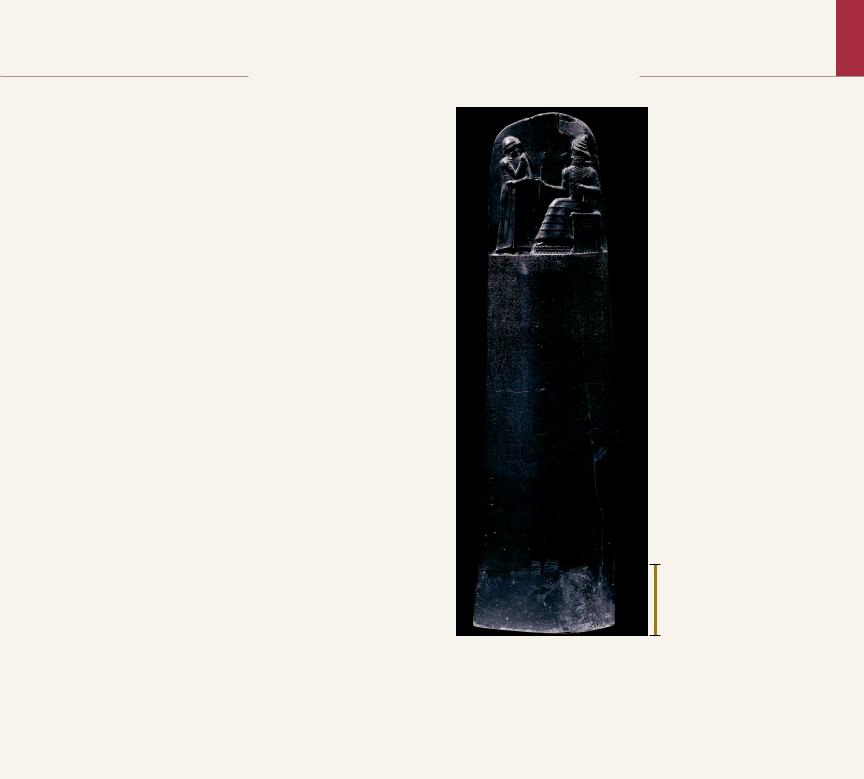
A R T A N D S O C I E T Y
Hammurabi’s Law Code
In the early 18th century BCE, King Hammurabi of Babylon formulated a comprehensive law code for his people. At the time, parts of Europe were still in the Stone Age. Even in Greece, it was not until more than 1,000 years later that Draco provided Athens with its first written set of laws. Two earlier Sumerian law codes survive in part, but Hammurabi’s laws are the only ones known in great detail, thanks to the chance survival of a tall black-basalt stele (FIG. 2-17) that was carried off as booty to Susa in 1157 BCE, together with the Naram-Sin stele (FIG. 2-13). At the top (FIG. 2-1) is a representation in high relief of Hammurabi in the presence of Shamash, the flame-shouldered sun god. The king raises his hand in respect. The god extends to Hammurabi the rod and ring that symbolize authority. The symbols derive from builders’ tools—measuring rods and coiled rope—and connote the ruler’s capacity to build the social order and to measure people’s lives, that is, to render judgments and enforce the laws spelled out on the stele. The judicial code, written in Akkadian, was inscribed in 3,500 lines of cuneiform characters. Hammurabi’s laws governed all aspects of Babylonian life, from commerce and property to murder and theft to marital fidelity, inheritances, and the treatment
of slaves.
Here is a small sample of the infractions described and the penalties imposed (which vary with the person’s standing in society):
If a man puts out the eye of another man, his eye shall be put out.
If he kills a man’s slave, he shall pay one-third of a mina.
If someone steals property from a temple, he will be put to death, as will the person who receives the stolen goods.
If a man rents a boat and the boat is wrecked, the renter shall replace the boat with another.
If a married woman dies before bearing any sons, her dowry shall be repaid to her father, but if she gave birth to sons, the dowry shall belong to them.
If a man’s wife is caught in bed with another man, both will be tied up and thrown in the water.
Hammurabi’s stele is noteworthy artistically as well. The sculptor depicted Shamash (FIG. 2-1) in the familiar convention of combined front and side views, but with two important exceptions. His great headdress with its four pairs of horns is in true profile so that only four, not all eight, of the horns are visible. And the artist seems
2-17 Stele with law code of Hammurabi, from Susa, Iran, ca. 1780 BCE. Basalt, 7 4 high. Louvre, Paris.
The stele that records Hammurabi’s remarkably early law code also is one of the first examples of an artist employing foreshortening—the representation of a figure or object at an angle (compare FIG. 2-1).
1 ft.
to have tentatively explored the notion of foreshortening—a means of suggesting depth by representing a figure or object at an angle, instead of frontally or in profile. Shamash’s beard is a series of diagonal rather than horizontal lines, suggesting its recession from the picture plane, and the sculptor represented the side of his throne at an angle.
SECOND MILLENNIUM BCE
The resurgence of Sumer was short-lived. The last of the kings of the Third Dynasty of Ur fell at the hands of the Elamites, who ruled the territory east of the Tigris River. The following two centuries witnessed the reemergence of the traditional Mesopotamian political pattern of several independent city-states existing side by side.
HAMMURABI Babylon was one of those city-states until its most powerful king, Hammurabi (r. 1792–1750 BCE), reestablished a centralized government in southern Mesopotamia. Perhaps the most renowned king in Mesopotamian history, Hammurabi was famous
for his conquests. But he is best known today for his law code (FIGS. 2-1 and 2-17), which prescribed penalties for everything from adultery and murder to the cutting down of a neighbor’s trees (see “Hammurabi’s Law Code,” above).
LION GATE, HATTUSA The Babylonian Empire toppled in the face of an onslaught by the Hittites, an Anatolian people who conquered and sacked Babylon around 1595 BCE. They then retired to their homeland, leaving Babylon in the hands of the Kassites. Remains of the strongly fortified capital city of the Hittites still may be seen at Hattusa near modern Boghazköy, Turkey. Constructed of large blocks
The Second Millennium BCE |
29 |
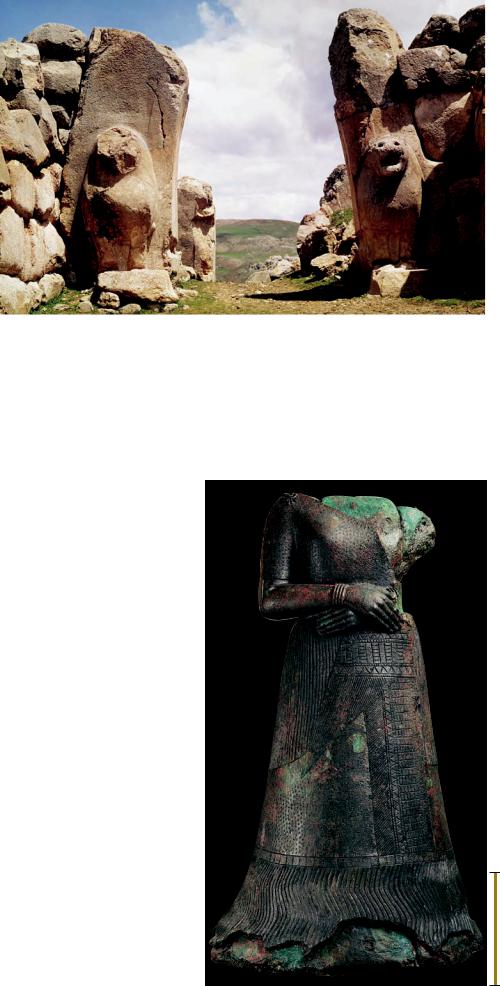
2-18 Lion Gate, Hattusa (modern Boghazköy), Turkey, ca. 1400 BCE.
The Hittites conquered and sacked Babylon around 1595 BCE. Their fortified capital at Boghazköy in Anatolia had seven-foot-tall stone lions guarding the main gateway (compare FIGS. 2-21 and 4-19).
of heavy stone—a striking contrast to the brick architecture of Mesopotamia—the walls and towers of the Hittites effectively protected them from attack. Symbolically guarding the gateway (FIG. 2-18) to the Hattusa citadel are two huge (seven-foot- high) lions. Their simply carved forequarters project from massive stone blocks on
either side of the entrance. These Hittite guardian beasts are early examples of a theme that was to be echoed on many Near Eastern gates. Notable are those of Assyria (FIG. 2-21), one of the greatest empires of the ancient world, and of the reborn Babylon (FIG. 2-24) in the first millennium BCE. But the idea of protecting a city, palace, temple, or tomb from evil by placing wild beasts or fantastic monsters before an entranceway was not unique to the Near Eastern world. Examples abound in Egypt, Greece, Italy, and elsewhere.
NAPIR-ASU OF ELAM To the east of Sumer, Akkad, and Babylon was Elam, which appears in the Bible as early as Genesis 10:22. During the second half of the second millennium BCE, Elam reached the height of its political and military power. At this time the Elamites were strong enough to plunder Babylonia and to carry off the stelae of Naram-Sin and Hammurabi (FIGS. 2-13 and 2-17) and display them as war booty at their capital city, Susa.
In the ruins of Susa, archaeologists discovered a life-size bronze- and-copper statue (FIG. 2-19) of Queen Napir-Asu, wife of one of the most powerful Elamite kings, Untash-Napirisha. The statue weighs 3,760 pounds even in its fragmentary and mutilated state, because the sculptor, incredibly, cast the statue with a solid bronze core inside a hollow-cast copper shell. The bronze core increased the cost of the statue enormously, but the queen wished her portrait to be a permanent, immovable votive offering in the temple where it was found. In fact, the Elamite inscription on the queen’s skirt explicitly asks the gods to protect the statue:
have come from close observation. The sculptor conveyed the feminine softness of arm and bust, the grace and elegance of the longfingered hands, the supple and quiet bend of the wrist, the ring and bracelets, and the gown’s patterned fabric. The loss of the head is especially unfortunate. The figure presents a portrait of the ideal queen. The hands crossed over the belly may allude to fertility and the queen’s role in assuring peaceful dynastic succession.
He who would seize my statue, who would smash it, who would destroy its inscription, who would erase my name, may he be smitten by the curse of [the gods], that his name shall become extinct, that his offspring be barren. . . . This is Napir-Asu’s offering.1
Napir-Asu’s portrait thus falls within the votive tradition going back to the third-millennium BCE Eshnunna figurines (FIG. 2-6). In the Elamite statue, the Mesopotamian instinct for cylindrical volume is again evident. The tight silhouette, strict frontality, and firmly crossed hands held close to the body are all enduring characteristics common to the Sumerian statuettes. Yet within these rigid conventions of form and pose, the Elamite artist managed to create refinements that must
2-19 Statue of Queen Napir-Asu, from Susa, Iran, ca. 1350–1300 BCE. Bronze and copper,
4 2 –3 high. Louvre,
4
Paris.
This life-size bronze- and-copper statue of the wife of one of the most powerful Elamite kings weighs 3,760
pounds. The queen
1 ft.
wanted her portrait to be an immovable votive offering in a temple.
30 Chapter 2 T H E A N C I E N T N E A R E A S T
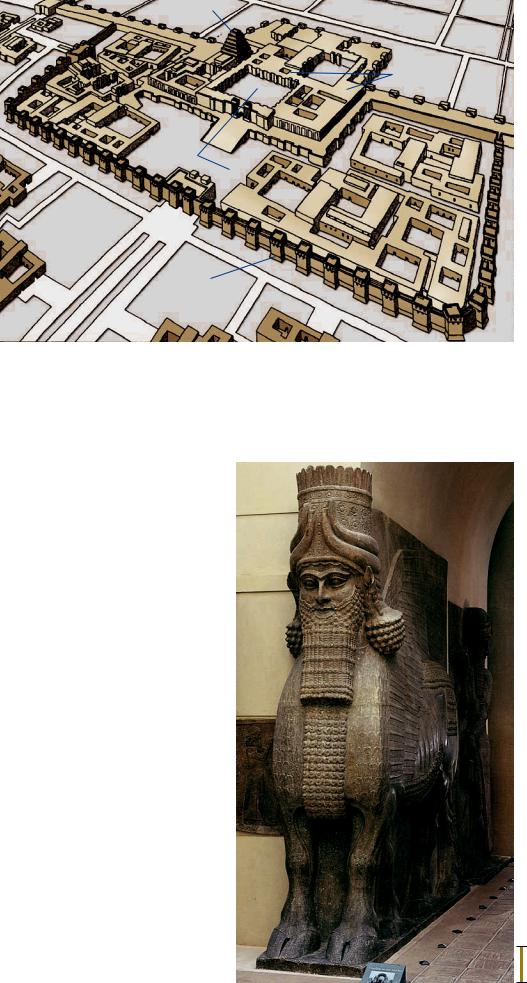
A S S Y R I A |
Ziggurat |
|
During the first half of the first mil- |
|
|
lennium BCE, the fearsome Assyrians |
|
|
vanquished the various warfaring |
|
|
peoples that succeeded the Babylo- |
|
|
nians and Hittites, including the |
|
|
Elamites, whose capital of Susa they |
|
|
sacked in 641 BCE. The Assyrians |
|
|
took their name from Assur, the city |
Courtyards |
|
on the Tigris River in northern Iraq |
||
|
||
named for the god Ashur. At the |
|
|
height of their power, the Assyrians |
|
|
ruled an empire that extended from |
|
|
the Tigris River to the Nile and from |
|
|
the Persian Gulf to Asia Minor. |
|
|
The royal citadel (FIG. 2-20) of |
|
|
Sargon II (r. 721–705 BCE) at Dur |
Citadel |
|
Sharrukin reveals in its ambitious |
walls |
|
layout the confidence of the Assyrian |
|
|
kings in their all-conquering might. |
|
|
Its strong defensive walls also reflect |
|
|
a society ever fearful of attack during |
2-20 |
|
a period of almost constant warfare. |
ca. 720–705 BCE (after Charles Altman). |
|
The city measures about a square |
|
|
mile in area. The palace, elevated on a |
|
|
mound 50 feet high, covered some 25 |
|
|
acres and had more than 200 court- |
|
yards and rooms. Timber-roofed rectangular halls were grouped around square and rectangular courts. Behind the main courtyard, whose sides each measured 300 feet, were the residential quarters of the king, who received foreign emissaries in the long, high, brightly painted throne room. All visitors entered from another large courtyard, where over-life-size figures of the king and his courtiers lined the walls.
Sargon II regarded his city and palace as an expression of his grandeur. The Assyrians cultivated an image of themselves as merciless to anyone who dared oppose them, although they were forgiving to those who submitted to their will. Sargon, for example, wrote in an inscription, “I built a city with [the labors of] the peoples subdued by my hand, whom Ashur, Nabu, and Marduk had caused to lay themselves at my feet and bear my yoke.” And in another text, he proclaimed, “Sargon, King of the World, has built a city. Dur Sharrukin he has named it. A peerless palace he has built within it.”
In addition to the complex of courtyards, throne room, state chambers, service quarters, and guard rooms that made up the palace, the citadel included a great ziggurat and six sanctuaries for six different
gods. The ziggurat at Dur Sharrukin may have had as |
2-21 Lamassu (winged, |
|
many as seven stories. Four remain, each 18 feet high |
||
and painted a different color. A continuous ramp spi- |
human-headed bull), from |
|
the citadel of Sargon II, |
||
raled around the building from its base to the temple at |
||
Dur Sharrukin (modern |
||
its summit. Here, the legacy of the Sumerian bent-axis |
||
Khorsabad), Iraq, ca. |
||
plan may be seen more than two millennia after the |
||
720–705 BCE. Limestone, |
||
erection of the White Temple (FIG. 2-3) on the ziggurat |
||
13 10 high. Louvre, Paris. |
||
at Uruk. |
||
Ancient sculptors insisted |
||
Guarding the gate to Sargon’s palace were colos- |
||
on showing complete |
||
sal limestone monsters (FIG. 2-21), which the Assyr- |
||
views of animals. This |
||
ians probably called lamassu. These winged, man- |
||
four-legged Assyrian |
||
headed bulls served to ward off the king’s enemies. |
||
palace guardian has five |
||
The task of moving and installing these immense |
||
legs—two when seen from |
||
stone sculptures was so daunting that several reliefs |
the front and four in profile |
|
in the palace of Sargon’s successor celebrate the feat, |
view. |
Reception halls and residential complex
1 ft.
Assyr ia 31

1 ft.
2-22 Assyrian archers pursuing enemies, relief from the Northwest Palace of Ashurnasirpal II, Kalhu (modern Nimrud), Iraq, ca. 875–860 BCE.
Gypsum, 2 10–5 high. British Museum, London.
8
Assyrian palaces were adorned with extensive series of narrative reliefs exalting the king and recounting his great deeds. This one depicts Assyrian archers driving the enemy into the Euphrates River.
showing scores of men dragging lamassu figures with the aid of ropes and sledges. The Assyrian lamassu sculptures are partly in the round, but the sculptor nonetheless conceived them as high reliefs on adjacent sides of a corner. They combine the front view of the animal at rest with the side view of it in motion. Seeking to present a complete picture of the lamassu from both the front and the side, the sculptor gave the monster five legs—two seen from the front, four seen from the side. This sculpture, then, is yet another case of early artists’ providing a conceptual picture of an animal or person and of all its important parts, as opposed to an optical view of the lamassu as it actually would stand in space.
PALACE OF ASHURNASIRPAL II For their palace walls the Assyrian kings commissioned extensive series of painted narrative re-
liefs exalting royal power. The degree of documentary detail in the Assyrian reliefs is without parallel in the ancient world before the Roman Empire (see Chapter 7). One of the earliest and most extensive cycles of reliefs comes from the palace of Ashurnasirpal II (r. 883–859 BCE) at Kalhu. Throughout the palace, painted gypsum reliefs sheathed the lower parts of the mud-brick walls below brightly colored plaster. Rich textiles on the floors contributed to the luxurious ambience. Every relief celebrated the king and bore an inscription naming Ashurnasirpal and describing his accomplishments.
FIG. 2-22 probably depicts an episode that occurred in 878 BCE when Ashurnasirpal drove his enemy’s forces into the Euphrates River. In the relief, two Assyrian archers shoot arrows at the fleeing foe. Three enemy soldiers are in the water. One swims with an arrow in his back. The other two attempt to float to safety by inflating animal
1 ft.
2-23 Ashurbanipal hunting lions, relief from the North Palace of Ashurbanipal, Nineveh (modern Kuyunjik), Iraq, ca. 645–640 BCE. Gypsum, 5 4 high. British Museum, London.
In addition to ceremonial and battle scenes, the hunt was a common subject of Assyrian palace reliefs. The Assyrians considered the hunting and killing of lions manly royal virtues on a par with victory in warfare.
32 Chapter 2 T H E A N C I E N T N E A R E A S T
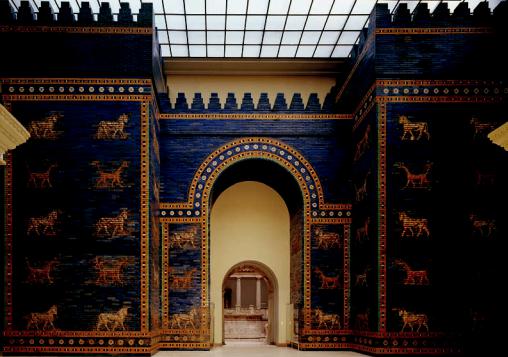
skins. Their destination is a fort where their compatriots await them. The artist showed the fort as if it were in the middle of the river, but it must, of course, have been on land, perhaps at some distance from where the escapees entered the water. The artist’s purpose was to tell the story clearly and economically. In art, distances can be compressed and the human actors enlarged so that they stand out from their environment. Literally interpreted, the defenders of the fort are too tall to walk through its archway. (Compare Naram-Sin and his men scaling a mountain, FIG. 2-13.) The sculptor also combined different viewpoints in the same frame, just as the figures are composites of frontal and profile views. The river is seen from above; the men, trees, and fort from the side. The artist also made other adjustments for clarity. The archers’ bowstrings are in front of their bodies but behind their heads in order not to hide their faces. The men will snare their own heads in their bows when they launch their arrows! All these liberties with optical reality result, however, in a vivid and easily legible retelling of a decisive moment in the king’s victorious campaign. This was the artist’s primary goal.
PALACE OF ASHURBANIPAL Two centuries later, sculptors carved hunting reliefs for the Nineveh palace of the conqueror of Elamite Susa, Ashurbanipal (r. 668–627 BCE). The Assyrians, like many other societies before and after, regarded prowess in hunting as a manly virtue on a par with success in warfare. The royal hunt did not take place in the wild, however, but in a controlled environment, ensuring the king’s safety and success. In FIG. 2-23, lions released from cages in a large enclosed arena charge the king, who, in his chariot and with his attendants, thrusts a spear into a savage lion. The animal leaps at the king even though it already has two arrows in its body. All around the royal chariot is a pathetic trail of dead and dying animals, pierced by what appear to be far more arrows than needed to kill them. Blood streams from some of the lions, but they refuse to die. The artist brilliantly depicted the straining muscles, the swelling veins, the muzzles’ wrinkled skin, and the flattened ears of the powerful and defiant beasts. Modern sympathies make this scene of carnage a kind of heroic tragedy, with the lions as protagonists. It is unlikely, however, that the king’s artists had any intention other
than to glorify their ruler by showing the king of men pitting himself against and repeatedly conquering the king of beasts. Portraying Ashurbanipal’s beastly foes as possessing courage and nobility as well as the power to kill made the king’s accomplishments that much grander.
The Assyrian Empire was never very secure, and most of its kings had to fight revolts in large sections of the Near East. Assyria’s conquest of Elam in the seventh century BCE and frequent rebellions in Babylonia apparently overextended its resources. During the last years of Ashurbanipal’s reign, the empire began to disintegrate. Under his successors, it collapsed from the simultaneous onslaught of the Medes from the east and the resurgent Babylonians from the south. Neo-Babylonian kings held sway over the former Assyrian Empire until the Persian conquest.
NEO - BABYLONIA AND PERSIA
The most renowned of the Neo-Babylonian kings was Nebuchadnezzar II (r. 604–562 BCE), whose exploits the biblical Book of Daniel recounts. Nebuchadnezzar restored Babylon to its rank as one of the great cities of antiquity. The city’s famous hanging gardens were among the Seven Wonders of the ancient world, and the Bible immortalized its enormous ziggurat as the Tower of Babel (see “Babylon, City of Wonders,” page 34).
ISHTAR GATE, BABYLON Nebuchadnezzar’s Babylon was a mud-brick city, but dazzling blue-glazed bricks faced the most important monuments, such as the Ishtar Gate (FIG. 2-24), actually a pair of gates, one of which has been restored and installed in a German museum. The Ishtar Gate consists of a large arcuated (arch- shaped) opening flanked by towers, and features glazed bricks with molded reliefs of animals, real and imaginary. Each Babylonian brick was molded and glazed separately, then set in proper sequence on the wall. On the Ishtar Gate, profile figures of Marduk and Nabu’s dragon and Adad’s bull alternate. Lining the processional way leading up to the gate were reliefs of Ishtar’s sacred lion, glazed in yellow, brown, and red against a blue background.
2-24 Ishtar Gate (restored), Babylon, Iraq, ca. 575 BCE. Glazed brick. Vorderasiatisches Museum, Staatliche Museen zu Berlin, Berlin.
Babylon under King Nebuchadnezzar II was one of the greatest cities of the ancient world. Its arcuated Ishtar Gate featured glazed bricks depicting Marduk and Nabu’s dragon and Adad’s bull.
Neo-Babylonia and Persia 33

W R I T T E N S O U R C E S
Babylon, City of Wonders
The uncontested list of the Seven Wonders of the ancient world was not codified until the 16th century. But already in the second century BCE, Antipater of Sidon, a Greek poet, compiled a roster of seven must-see monuments, including six of the seven later Wonders. All of the Wonders were of colossal size and constructed at great expense. Three of them were of great antiquity: the pyramids of Gizeh (FIG. 3-8), which Antipater described as “man-made mountains,” and
“the hanging gardens” and “walls of impregnable Babylon.” Babylon was the only site on Antipater’s list that could boast two
Wonders. Later list makers preferred to distribute the Seven Wonders among seven different cities. Most of these Wonders date to Greek times—the Temple of Artemis at Ephesos, with its 60-foot-tall columns; Phidias’s colossal gold-and-ivory statue of Zeus at Olympia; the grandiose tomb of Mausolus (the “Mausoleum”) at Halikarnassos; the Colossus of Rhodes, a bronze statue of the sun god 110 feet tall; and the lighthouse at Alexandria, perhaps the tallest building in the ancient world. The pyramids are the oldest and the Babylonian gardens the only Wonder in the category of “landscape architecture.”
Several ancient texts describe Babylon’s gardens. Quintus Curtius Rufus, writing in the mid-first century CE, reported:
On the top of the citadel are the hanging gardens, a wonder celebrated in the tales of the Greeks. . . . Columns of stone were set up to sustain the whole work, and on these was laid a floor of squared blocks, strong enough to hold the earth which is thrown upon it to a great depth, as well as the water with which they irrigate the soil; and the structure supports trees of such great size that the thickness of their trunks equals a measure of eight cubits [about twelve feet]. They tower to a height of fifty feet, and they yield as much fruit as if they
were growing in their native soil. . . . To those who look upon [the trees] from a distance, real woods seem to be overhanging their native mountains.*
Not qualifying as a Wonder, but in some ways no less impressive, was Babylon’s Marduk ziggurat, the biblical Tower of Babel. According to the Bible, humankind’s arrogant desire to build a tower to Heaven angered God. The Lord put an end to it by causing the workers to speak different languages, preventing them from communicating with one another. The fifth-century BCE Greek historian Herodotus described the Babylonian temple complex:
In the middle of the sanctuary [of Marduk] has been built a solid tower . . . which supports another tower, which in turn supports another, and so on: there are eight towers in all. A stairway has been constructed to wind its way up the outside of all the towers; halfway up the stairway there is a shelter with benches to rest on, where people making the ascent can sit and catch their breath. In the last tower there is a huge temple. The temple contains a large couch, which is adorned with fine coverings and has a golden table standing beside it, but there are no statues at all standing there. . . . [The Babylonians] say that the god comes in person to the temple [compare the Sumerian notion of the temple as a “waiting room”] and rests on the couch; I do not believe this story myself.†
*Translated by John C. Rolfe, Quintus Curtius I (Cambridge, Mass.: Harvard University Press, 1971), 337–339.
†Translated by Robin Waterfield, Herodotus: The Histories (New York: Oxford University Press, 1998), 79–80.
THE PERSIAN EMPIRE Although Nebuchadnezzar,“King of Kings” of the biblical Daniel, had boasted that he “caused a mighty wall to circumscribe Babylon . . . so that the enemy who would do evil would not threaten,” Cyrus of Persia (r. 559–529 BCE) captured the city in the sixth century. Cyrus, who may have been descended from an Elamite line, was the founder of the Achaemenid dynasty and traced his ancestry back to a mythical King Achaemenes. Babylon was but one of the Persians’ conquests. Egypt fell to them in 525 BCE, and by 480 BCE the Persian Empire was the largest the world had yet known, extending from the Indus River in South Asia to the Danube River in northeastern Europe. Only the successful Greek resistance in the fifth century BCE prevented Persia from embracing southeastern Europe as well. The Achaemenid line ended with the death of Darius III in 330 BCE, after his defeat at the hands of Alexander the Great (FIG. 5-70).
PERSEPOLIS The most important source of knowledge about Persian art and architecture is the ceremonial and administrative complex on the citadel at Persepolis (FIG. 2-25), which the successors of Cyrus, Darius I (r. 522–486 BCE) and Xerxes (r. 486–465 BCE), built between 521 and 465 BCE. Situated on a high plateau, the heavily fortified complex of royal buildings stood on a wide platform overlooking the plain. Alexander the Great razed the site in a gesture symbolizing the destruction of Persian imperial power. Some said it was an act of revenge for the Persian sack of the Athenian Acropolis in the early fifth century BCE (see Chapter 5). But even in ruins, the Persepolis citadel is impressive.
The approach to the citadel led through a monumental gateway called the Gate of All Lands, a reference to the harmony among the peoples of the vast Persian Empire. Assyrian-inspired colossal manheaded winged bulls flanked the great entrance. Broad ceremonial stairways provided access to the platform and the royal audience hall, or apadana, a huge hall 60 feet high and 217 feet square, containing 36 colossal columns. An audience of thousands could have stood within the hall.
The reliefs (FIG. 2-26) decorating the walls of the terrace and staircases leading to the apadana represent processions of royal guards, Persian nobles and dignitaries, and representatives from 23 subject nations bringing the king tribute. Every one of the emissaries wears his national costume and carries a typical regional gift for the conqueror. The carving of the Persepolis reliefs is technically superb, with subtly modeled surfaces and crisply chiseled details. Traces of color prove that the reliefs were painted, and the original effect must have been even more striking than it is today. Although the Persepolis sculptures may have been inspired by those in Assyrian palaces, they are different in style. The forms are more rounded, and they project more from the background. Some of the details, notably the treatment of drapery folds, echo forms characteristic of Archaic Greek sculpture (see Chapter 5), and Greek influence seems to be one of the many ingredients of Achaemenid style. Persian art testifies to the active exchange of ideas and artists among all the Mediterranean and Near Eastern civilizations at this date. A building inscription at Susa, for example, names Ionian Greeks, Medes, Egyp-
34 Chapter 2 T H E A N C I E N T N E A R E A S T
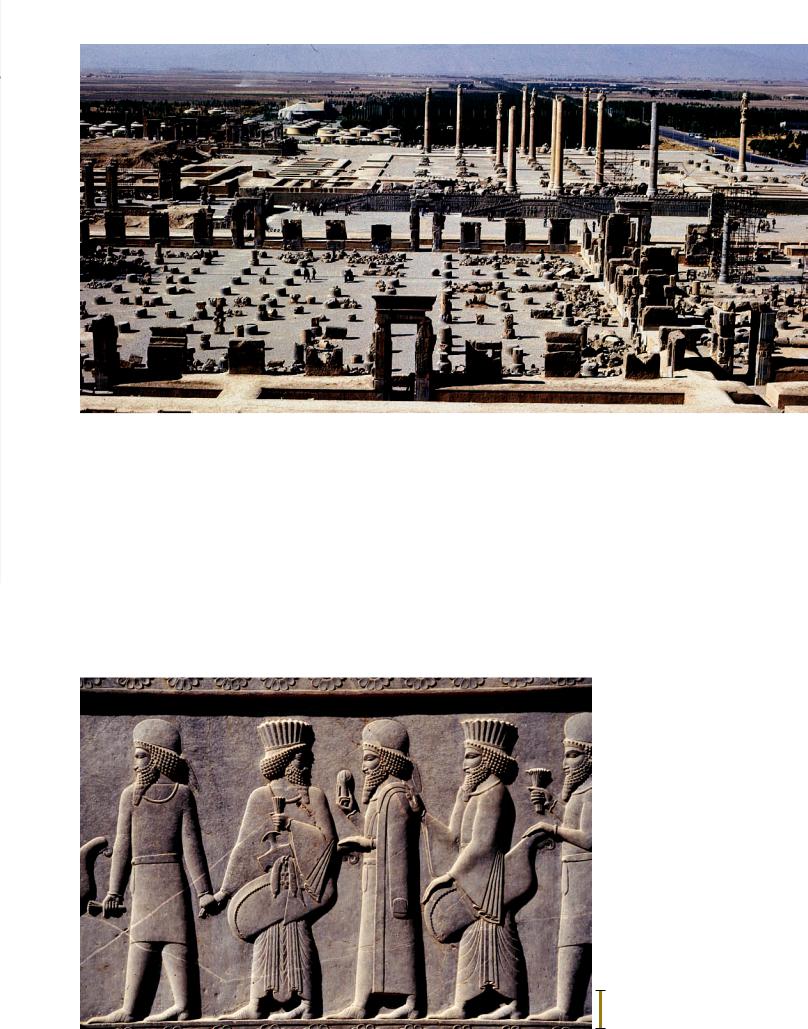
2-25 Aerial view (looking west) of Persepolis (apadana in the background), Iran, ca. 521–465 BCE.
The heavily fortified complex of Persian royal buildings on a high plateau at Persepolis contained a royal audience hall, or apadana, 60 feet high and 217 feet square with 36 colossal columns.
tians, and Babylonians among those who built and decorated the palace. Under the single-minded direction of its Persian masters, this heterogeneous workforce, with a widely varied cultural and artistic background, created a new and coherent style that perfectly suited the expression of Persian imperial ambitions.
SASANIAN CTESIPHON Alexander the Great’s conquest of Persia in 330 BCE marked the beginning of a long period of first Greek and then Roman rule of large parts of the ancient Near East,
beginning with one of Alexander’s former generals, Seleucus I (r. 312–281 BCE), founder of the Seleucid dynasty. In the third century CE, however, a new power rose up in Persia that challenged the Romans and sought to force them out of Asia. The new rulers called themselves Sasanians. They traced their lineage to a legendary figure named Sasan, said to be a direct descendant of the Achaemenid kings. Their New Persian Empire was founded in 224 CE, when the first Sasanian king, Artaxerxes I (r. 211–241), defeated the Parthians (another of Rome’s eastern enemies).
2-26 Processional frieze (detail) on the terrace of the apadana, Persepolis, Iran, ca. 521–465 BCE. Limestone,
8 4 high.
The reliefs decorating the walls of the terrace and staircases leading up to the Persepolis apadana included depictions of representatives of 23 subject nations bringing tribute to the Persian king.
1 ft.
Neo-Babylonia and Persia 35

2-27 Palace of Shapur I, Ctesiphon, Iraq, ca. 250 CE.
The last great pre-Islamic civilization of the Near East was that of the Sasanians. Their palace at Ctesiphon, near Baghdad, features a brick audience hall (iwan) covered by an enormous pointed vault.
The son and successor of Artaxerxes, Shapur I (r. 241–272), succeeded in further extending Sasanian territory. He also erected a great palace (FIG. 2-27) at Ctesiphon, the capital his father had established near modern Baghdad in Iraq. The central feature of Shapur’s palace was the monumental iwan, or brick audience hall, covered by a vault (here, a deep arch over an oblong space) that came almost to a point more than 100 feet above the ground. The facade to the left and right of the iwan was divided into a series of horizontal bands made up of blind arcades, a series of arches without actual openings, applied as wall decoration. A thousand years later, Islamic architects looked at Shapur’s palace and especially its soaring iwan and established it as the standard for judging their own engineering feats (see Chapter 10).
SHAPUR I AND ROME So powerful was the Sasanian army that in 260 CE Shapur I even succeeded in capturing the Roman emperor Valerian near Edessa (Turkey). His victory over Valerian was
2-28 Triumph of Shapur I over Valerian, rock-cut relief, Bishapur, Iran, ca. 260 CE.
The Sasanian king Shapur I humiliated the Roman emperor Valerian in 260 CE and commemorated his surrender in over-life-size reliefs cut into the cliffs outside Persepolis.
such a significant event that Shapur commemorated it in a series of rock-cut reliefs in the cliffs of Bishapur in Iran, far from the site of his triumph. FIG. 2-28 reproduces one of the Bishapur reliefs. Shapur appears larger than life, riding in from the right wearing the distinctive tall Sasanian crown, which breaks through the relief ‘s border and draws attention to the king. At the left, Valerian kneels before Shapur and begs for mercy. Similar scenes of kneeling enemies before triumphant generals are commonplace in Roman art— but at Bishapur the roles are reversed. This appropriation of Roman compositional patterns and motifs in a relief celebrating the Sasanian defeat of the Romans adds another, ironic, level of meaning to the political message in stone.
The New Persian Empire endured more than 400 years, until the Arabs drove the Sasanians out of Mesopotamia in 636 CE, just four years after the death of Muhammad. Thereafter, the greatest artists and architects of Mesopotamia worked in the service of Islam (see Chapter 10).
36 Chapter 2 T H E A N C I E N T N E A R E A S T
